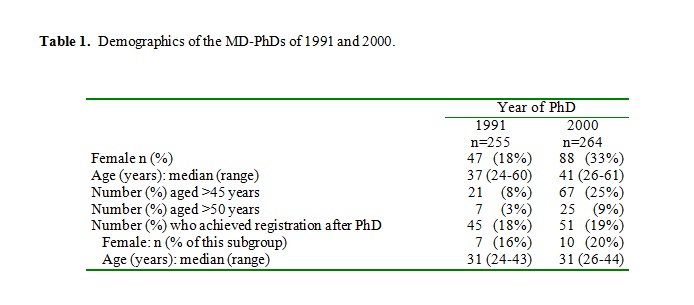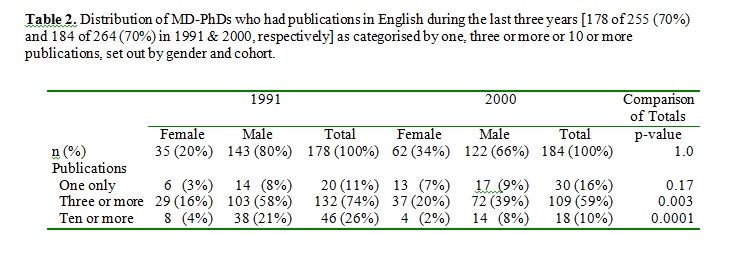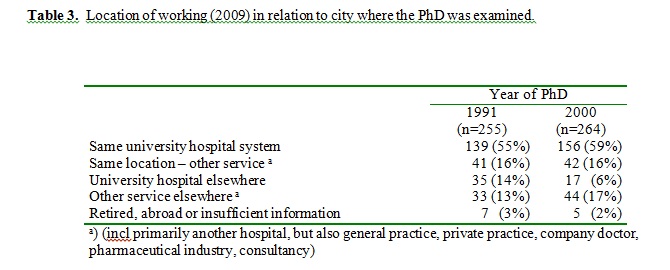ABSTRACT
About 70% of Swedish MDs who passed their PhD in 1991 and 2000 published papers in English during the last three years. The proportions with three or more and with 10 or more publications were significantly less in the 2000 than in the 1991 cohort. A smaller proportion of those of 2000 than of 1991 had moved to universities other than where they did their PhD. The age at PhD was skewed towards the older end in the more recent cohort. About 40% of the external examiners of the theses were based abroad. Explanations for the pattern of their publications and changed pattern of working are discussed, including issues of mobility and career opportunities. It is worth encouraging medical students and doctors to engage in research but resources must be provided including opportunities to move to other universities to encourage a broader development.
INTRODUCTION
Research is fundamental to developing new methods of treatment and patient care. Therefore, higher education policy and management view positively the encouraging of medical students and doctors to undertake research. The demographics of PhD graduates and the structure of their theses, including MD-PhDs, have been described in a number of surveys but there is a scarcity of outcomes measures.1-5 A survey of the European Molecular Biology Organisation (EMBO) Long Term Fellows found that more than 75% were active in research, defined by whether they were publishing a decade after their fellowship.6 A survey by the Swedish higher education authority published this year found that 30% of the newly starting PhD students in Sweden hailed from abroad and of those who had passed their PhD-examination, about half were still living in Sweden five years after completing their PhD.7 Sweden has a tradition of a high proportion of their MDs undertaking PhDs.3-5 This study attempts to describe how the careers of Swedish medical graduates who undertook a PhD developed, with emphasis on whether they continued with research.
MATERIALS AND METHODS
Details of Swedish biomedical PhDs are provided in structured announcements in the Swedish Medical Journal (Läkartidningen). The information also includes the name and country of the primary external examiner. I surveyed the announcements for the years 1991 and 2000. To identify those who were medical graduates, listings of registered doctors in Sweden were manually consulted.8-10 In cases of common names, the date of birth provided a unique identifier. The years of cohorts were chosen so that the doctors’ careers could be expected to have stabilised. They would have had a chance to complete their specialist training and reach “attending” (“consultant”) status but not too many would have retired or died. The most up to date location and type of work (such as teaching hospital, general practice, pharmaceutical industry) were identified. A Medline (PubMed) analysis was performed of the publications in English listed under the names (name and initial) of each person using the function for the last three years. Those identified in this way were considered by definition to be active in research. An output of three or more papers was considered to indicate a higher level of output. Because of name redundancy, to avoid overestimating the number publishing or the number of publications per name, each of the entries was checked for consistency of the research topic and co-authors, though because a person may change research direction after completing a PhD this methodology runs the risk of underestimating those still active. Statistical analysis used the GraphPad on line system (at http://www.graphpad.com). The results are shown in Tables 1-3.
RESULTS
Demographics. Overall 255 MDs in 1991 and 264 in 2000 were identified to have undertaken a PhD. The age distribution was skewed towards the older end in the 2000 than 1991 cohort (Table 1). In both 1991 and 2000 there was a subgroup (about 20%) of MDs who did their PhDs before completing their full registration with the Swedish General Medical Council (Socialstyrelsen). They did not differ in proportion, sex or age distribution between the two cohorts. They had the same median age of 31 years. For those who did their PhD after obtaining registration the median age (range) was 39 (29-60) in 1991 and 43 (29-61) in 2000.



Academic activity. About 70% of both those examined in 1991 (178/255) and in 2000 (184/264) were actively publishing in English during the last three years. Four persons were identified as professor (all in the 1991 cohort), and there were 27 chiefs of service in the 1991 and nine in the 2000 cohort. Such relative numbers would be expected and supports the validity of the databases. Overall, there were more doctors with three or more publications and 10 or more publications in the 1991 cohort than the 2000 cohort (p=0.003 and 0.0001, respectively) and less with only one single publication (not than 1991 cohort (Table 1). In both 1991 and 2000 there was a subgroup (about 20%) of MDs who did their PhDs before completing their full registration with the Swedish General Medical Council (Socialstyrelsen). They did not differ in proportion, sex or age distribution between the two cohorts. They had the same median age of 31 years. For those who did their PhD after obtaining registration the median age (range) was 39 (29-60) in 1991 and 43 (29-61) in 2000.
Academic activity. About 70% of both those examined in 1991 (178/255) and in 2000 (184/264) were actively publishing in English during the last three years. Four persons were identified as professor (all in the 1991 cohort), and there were 27 chiefs of service in the 1991 and nine in the 2000 cohort. Such relative numbers would be expected and supports the validity of the databases. Overall, there were more doctors with three or more publications and 10 or more publications in the 1991 cohort than the 2000 cohort (p=0.003 and 0.0001, respectively) and less with only one single publication (not than 1991 cohort (Table 1). In both 1991 and 2000 there was a subgroup (about 20%) of MDs who did their PhDs before completing their full registration with the Swedish General Medical Council (Socialstyrelsen). They did not differ in proportion, sex or age distribution between the two cohorts. They had the same median age of 31 years. For those who did their PhD after obtaining registration the median age (range) was 39 (29-60) in 1991 and 43 (29-61) in 2000.
Academic activity. About 70% of both those examined in 1991 (178/255) and in 2000 (184/264) were actively publishing in English during the last three years. Four persons were identified as professor (all in the 1991 cohort), and there were 27 chiefs of service in the 1991 and nine in the 2000 cohort. Such relative numbers would be expected and supports the validity of the databases. Overall, there were more doctors with three or more publications and 10 or more publications in the 1991 cohort than the 2000 cohort (p=0.003 and 0.0001, respectively) and less with only one single publication (not significant at p=0.17) (Table 2).
Location The majority of the members of both cohorts still worked in the same general location but there was a significant difference in those who had moved elsewhere (Table 3). In the 1991 cohort, out of 68 MDs who had moved to other locations, 35 were in other university hospitals and 33 in other forms practice (mainly hospitals) while out of the 61 MDs in the 2000 group, 17 moved to university hospitals and 44 to other institutions. This difference in pattern was statistically significant (p=0.008), though the numbers are small. Recruitment to the pharmaceutical industry was about the same, at five persons in 1991 and four in 2000. Taken as a whole, 70% (180) of the 1991 cohort and 75% (198) of the 2000 cohort remained in the same general location as where they had undertaken their PhD.
Internationalisation. A survey of biomedical theses in 2008 found that 50% were examined by foreign external examiners, with the majority from the USA, UK and the other Nordic countries.5 Here, 95 (37%) of the external examiners came from abroad in 1991 and 106 (40%) in 2000. In 1991, 11 were from the USA, 16 from UK and 52 from the contiguous Nordic countries (Norway 22, Finland 16 and Denmark 14) and the other 16 from seven countries. In 2000, there were 18 from USA, 26 UK and 42 for the contiguous Nordic countries (Norway nine, Finland 14 and Denmark 19) and the other 20 from 12 countries.
Analysis by gender. Women candidates comprised 47 (18%) of candidates in 1991 and 88 (33%) in 2000, a significant increase and consistent with secular trends. The comparatively small number of women and their almost doubling in number between 1991 and 2000 makes analysis based on gender uncertain. There was no significant difference in age distribution between men and women (data not shown). In the 1991 cohort, five of 27 chief positions were held by women, and in 2000 one of nine; the four professors were all male. Of the external examiners seven (7%) and 15 (14%) were women in 1991 and 2000, respectively. These figures are consistent with increasing female presence in higher echelons and supports the validity of the databases.11
There was no significant difference between 1991 and 2000 with regards to women who had or had not published in English during the last three years (35 vs. 12 compared with 62 vs. 26, p=0.69). The same was true for men (143 vs. 65 compared with 122 vs. 54, p=0.91). The pattern for three or more and 10 or more publications could be interpreted that the smaller number of women persisted more with publishing than their male counterparts but the differences did not reach significance.
Though the proportion of women candidates who had female examiners increased from 13% in 1991 to 20% in 2000, neither reached statistical significance when compared with the behaviour of men who also increasingly used female examiners (in 1991 – six out of 47 women compared with 15 of 208 for men, p=0.24; and in 2000 – 18 out of 88 compared with 21 out of 176, p=0.1). The changes probably reflect a combination between an increasing availability of women qualified to examine doctoral theses and choice of topics of study, though a preference for women to be examined by women cannot be excluded but is less likely.
DISCUSSION
The primary aim of this study was to ascertain whether MDs who undertook a PhD subsequently continued with research. The study used information readily available in the public domain. It did not rely on completion of surveys that could be subject to some selectivity and might be biased towards more successful doctorates. At the same time, the process runs the risk of missing or confusing doctors with common names who have changed fields of research or missing women who changed their surnames as a consequence of marriage. Nevertheless, the number of persons deemed active in research by publishing was found to be high at 70%, consistent with a lasting effect of the PhD-process. This compares well with the report that nearly 77% of EMBO Long-Term Fellows were actively publishing 10 years after their fellowship (88% of those who responded to a postal survey) in view of the high status of and competition for those post-doctoral fellowships and the high degree of funding provided to the fellows.6
The number of women and the change in their proportion makes the gender analysis uncertain but the overall pattern is consistent with an increased presence of women at the higher career levels.
Most people want to live and work in their own land. Sweden has a small population (nine million) and a big area (Europe’s third largest country after France and Spain). It has limited resources for research, and biomedical research is found in only a few (less than 10) cities. Mobility can be restricted because only rarely can a job for a partner be arranged. This may explain the high proportion (70-75%) of these professionals that remained in the same general location as where they undertook their PhD. Nevertheless, the pattern between the two cohorts appears to be different in one area: of those who moved away a smaller proportion had moved to other universities in the more recent cohort. This could be owed either to lack of funding to attract researchers or to different selection processes. Another explanation could be that the distances between universities requires a move and cannot be handled by long-distance or weekend-commuting (which has become popular in Sweden during the past 20 years or so). The level of mobility in other countries is not well documented, but it is generally held that it is rare for an MD-PhD in USA and Anglo-Saxon countries to be able to remain where they did their research degree. Using a listing in time gives only a snapshot – we cannot see the whole picture – and doctors spending a year or two abroad on a fellowship may not bother to update their address, but if reduced ability to move to another academic institution were to be confirmed for the new millennium (i.e., not a chance occurrence for the year of 2000), this may represent a reduction in opportunity.
The examination of Swedish PhDs is internationalised.5 In these cohorts about 40% of the examiners were from abroad, which compares with 50% in 2008 for a mixture of MDs and non-MDs.5 The decrease in examiners from the Nordic countries with an increase from USA and UK may reflect changes in cost of travel during the decade. Doctors, dentists and veterinarians represent an attractive talent pool to recruit scientists from because not only is their basic training both wide and specific, in addition these graduates have a natural career path back to clinical practice after their PhD and so look after themselves.12
The median ages at PhD of about 37 and 41 years fits with surveys from midway between these cohorts that reported an average age of 40 years for MD-PhDs, with 35 years for those who had not yet completed their specialist training and 30 for those submitting from a pre-clinical research department.2,3 Nevertheless, comparison between the two cohorts studied here, which are spaced by a decade, revealed an aging cadre. Though the median age of the two groups only rose by four years, nevertheless the spread increased considerably, with a skewed distribution of a long tail towards the older end in the 2000 cohort. The pattern of age distribution and timing of the PhD during their career is consistent with most candidates undertaking a PhD as a “rite-of-passage” rather than as a starting point.
In conclusion, it is encouraging that such a high proportion of Swedish MD-PhDs continue to be active in research as judged by publications in English during the last three years. At the same time, the change in the distribution of those publications, taken together with possible lack of mobility to other universities, may signal possibly shrinking career opportunities. A detailed official, ideally pan-European, survey is needed at least in 2020 and preferably sooner.
REFERENCES
- Breimer, L.H., and Mikhailidis, D.P. A thesis for all seasons. Nature. 1991; 353:789-790.
- Breimer, L.H., and Breimer, D.D. A computer-based international “Thesis-line”? Trends in Biochemical Sciences (TiBS). 1995; 20:175-176.
- Breimer, L.H. Age, sex and standards of current doctoral theses by Swedish medical graduates. Scientometrics. 1996; 37:171-176.
- Calltorp, J., Adami, H.O., Aström, H., Fryklund, L., Rossner, S., Trolle, Y., and Giesecke, J. Country profile: Sweden. Lancet. 1996; 347:587-594.
- Breimer, L.H. Swedish biomedical PhD examination: an international forum and a proposed procedure for Europe. Scientometrics, in press. DOI 10.1007/s11192-009-0081-3.
- Gannon., F., Norman, J., Kriis, M., Walker, A., and Breimer, L. EMBO fellows go home. Nature. 1997; 388:416-417.
- Högskoleverket (Swedish National Agency for Higher Education). Utländska doktorander i svensk forskarutbildning. Högskoleverkets rapportserie. 2009:14 R (ISSN 1400-948X).
- Socialstyrelsen. Förteckningen över Sveriges legitimerade läkare 2008/2009. ISBN 978-913832463-9. 939 pp. Stockholm, Sweden: Fritzes. 2009.
- Läkemedelsstatistik AB. Läkarmatrikeln 1998. ISBN 91-87514-00-1. 287pp. Göteborg, Sweden: Mediahuset i Göteborg AB. 1998.
- Cegedim AB. Läkarmatrikeln 2008. ISBN 978 91 87514 29 6. 333pp. Göteborg, Sweden: Mediahuset i Göteborg AB. 2008.
- EC (European Commission) (2003). She Figures 2003. Women and Science Statistics and Indicators. 114pp. Luxembourg: Office for the Official Publications of the European Communities. – available at http://ec.europa.eu/research/science-society/pdf/she_figures_2003.pdf Accessed February 24, 2010.
- Breimer, L.H. European community actions. Nature. 1991; 351: 599.